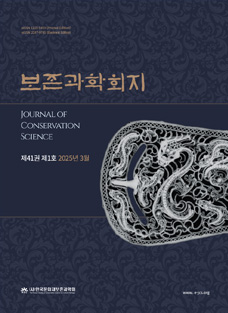Journal of Conservation Science Vol.31 No.1 pp.47-64
천안-아산 지역 청동기시대 무문토기의 재료학적 특성과 고고과학적 의미
Material Characteristics and Archaeological Scientific Implication of the Bronze Age Potteries from the Cheonan‐Asan Area, Korea
Chan Hee Lee,Seon Yeong Cho,Eon Il Eo,Ran Hee Kim
Abstract
The excavated potteries and raw clays of the Bronze Age from the archaeological sites in the Cheonan-Asan area were studied on material scientific characteristics and homogeneity. Under the microscope, grainsize of the tempers in the potteries were distributed from less than 1mm to 10mm. Microtexture of the potteries showed various shapes and sizes of pores. In addition to the main minerals such as quartz, feldspar, mica, hornblende, chlorite and talc were found from the X-ray diffraction analysis of potteries, while talc was not found in the raw clay. Therefore, it was considered as an artificially added mineral. Firing temperature of the potteries, which did not contain chlorite, are assumed that they were baked below 850℃. On the other hand, the potteries which had mica and talc, are assumed that they were fired below 900℃. The geochemical characteristics of the potteries and raw clays showed very similar patterns, that means the potteries were produced by using the raw clay sources from each site.

 E-Submission
E-Submission 
 E-Submission
E-Submission 
![]() Journal Search Engine
Journal Search Engine




 KSC
KSC